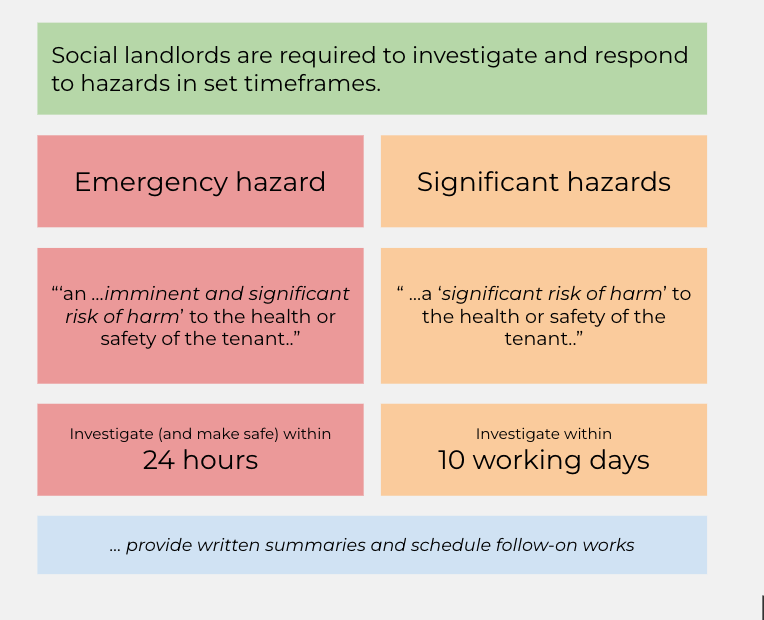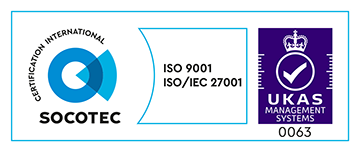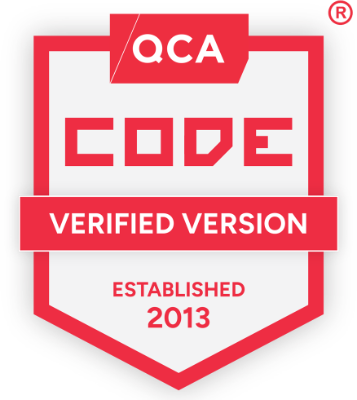The sector has been discussing the implications of Awaab’s Law, usually with a mix of uncertainty and fear, for much of the last year. The team at Made Tech Housing have been following developments and supporting customers like London Borough of Camden with some preparatory initiatives around streamlining damp and mould reporting.
However, it wasn’t until the draft guidance was published and we drilled down into the details of the proposed processes and obligations that we realised how significant a change this could be for our customers and how ill-equipped many existing solutions are for the type of deadline-oriented case management the guidance points towards.
Awaab’s Law – the fundamentals
To recap: Awaab’s Law requires social landlords to investigate and respond to hazards in set timeframes.
It defines different categories of hazards and the timeframes in which landlords must respond:
- Emergency Hazards – hazards that present an imminent and significant risk of harm to the health or safety of tenants. These must be investigated and, if required, made safe within 24 hours. As the guidance highlights, this aligns with how day-to-day repairs teams currently manage emergency repairs.
- Significant Hazards – hazards that present a serious risk of harm to tenant health or safety, where a reasonable landlord with the relevant knowledge (including the tenant’s individual circumstances) would take urgent steps to make safe. These must be investigated within 10 days.

The underlying admin burden
As my colleague Chris discussed with Dave Loudon in our recent webinar, there is considerable administrative complexity that landlords will need to manage to remain compliant:
- Reports coming in via multiple channels that need to be logged and acted on consistently.
- Investigations to schedule, with planning teams juggling deadlines and ensuring nothing slips through the cracks.
- Operative investigations that must be translated into tenant-friendly written summaries, produced within three days of completion.
- Scheduling and tracking follow-on works, often across multiple contractors and teams.
These obligations create a new layer of administrative pressure. Social landlords require more than just compliance processes; they need systems that simplify, automate, and keep pace with evolving legislation. That’s why we’re building Hazard Case Management for Awaab’s Law – a solution designed to help providers manage incoming reports, stay on top of deadlines, and generate tenant-friendly summaries automatically.
MHCLG’s data model, and how we’re using it.
We’re delivering this new product at pace, so we were encouraged to read MHCLG’s recent blog post and learn of the work they’ve been doing to develop a data standard for hazards.
The model, built with HACT’s UK Housing Data Standards, brings together all the necessary information for teams to meet their obligations under Awaabs’ Law. By breaking the process into clear components, it maps directly to how landlords work day-to-day – which makes it much easier for suppliers like us to translate the standard into usable software.
Investigation component: captures the details of hazard investigations. We’re using the investigation_notes field to feed into our AI-enabled summary generation, helping turn technical findings into clear tenant-friendly reports without adding to caseworkers’ admin burden.
Property component: links hazard reports to the properties they relate to. We plan to use this data to provide landlords with insights into the types of properties and property attributes where hazards are most likely to occur, enabling a more efficient and proactive service for tenants.
Work order component: records repair tasks that can be associated with a hazard case. Follow-on work is often where landlords drop the ball, as they struggle to piece together what work is required and when. Once an investigation is concluded and follow-on work is defined, we’ll enable tenants to book the work at a time that suits them through our tenant scheduling interface. This saves landlords time and admin, and increases the likelihood of tenants being home when operatives arrive.
Tenant component: captures tenant and household member details, including attributes such as vulnerabilities. This information is critical when making the initial categorisation of a hazard as significant or emergency. We’ll be using data from this component to flag vulnerabilities clearly to case handlers in our case details screens.
Appointments component: holds information about dates and times of scheduled hazard investigations. We’ll be using this data to help planners track which investigations are scheduled, which aren’t, and how long is left to meet the statutory timeframes.
Built for the future
With the scope of Awaab’s Law set to expand over the next two years, day-to-day repairs processes are going to start morphing more and more into the shape of the Awaab’s Law process – deadline-driven, tightly tracked, and requiring clear tenant communication (all of which will benefit tenants). The fact that the model already incorporates attributes like SoR codes is vital, because it means hazard management can be integrated seamlessly alongside wider responsive repairs operations.
What excites us most is the forward-looking design of the model. It’s not just about damp and mould today. Its modular structure anticipates the expansion of Awaab’s Law to cover all HHSRS Category 1 hazards, meaning the work we do now won’t need to be rebuilt later.
A foundation for sector-wide improvement
As MHCLG outlines in their article, poor data standards across the housing sector cost hundreds of millions each year. Awaab’s Law requires a repeatable, deadline-driven process that many landlords would struggle to design on their own. By providing a shared model, MHCLG is helping to set a baseline for how hazards are recorded and tracked.
Models like these create the conditions for greater data consistency in the sector, nudging both landlords and suppliers toward a common approach. In doing so, they reduce the risk of each organisation reinventing the wheel and make it far easier to build scalable solutions.
Conclusion
Awaab’s Law is a wake-up call for the sector. The deadlines are tight, the obligations are significant, and the risks of non-compliance are real. But with the right foundations, it’s also an opportunity to modernise housing services and improve tenant outcomes.
For Made Tech, MHCLG’s data model has accelerated delivery for Camden and Barking & Dagenham, giving us confidence that what we’re building today will scale seamlessly over the next two years. For the sector as a whole, it sets the stage for greater consistency, better data, and ultimately safer homes for tenants.







